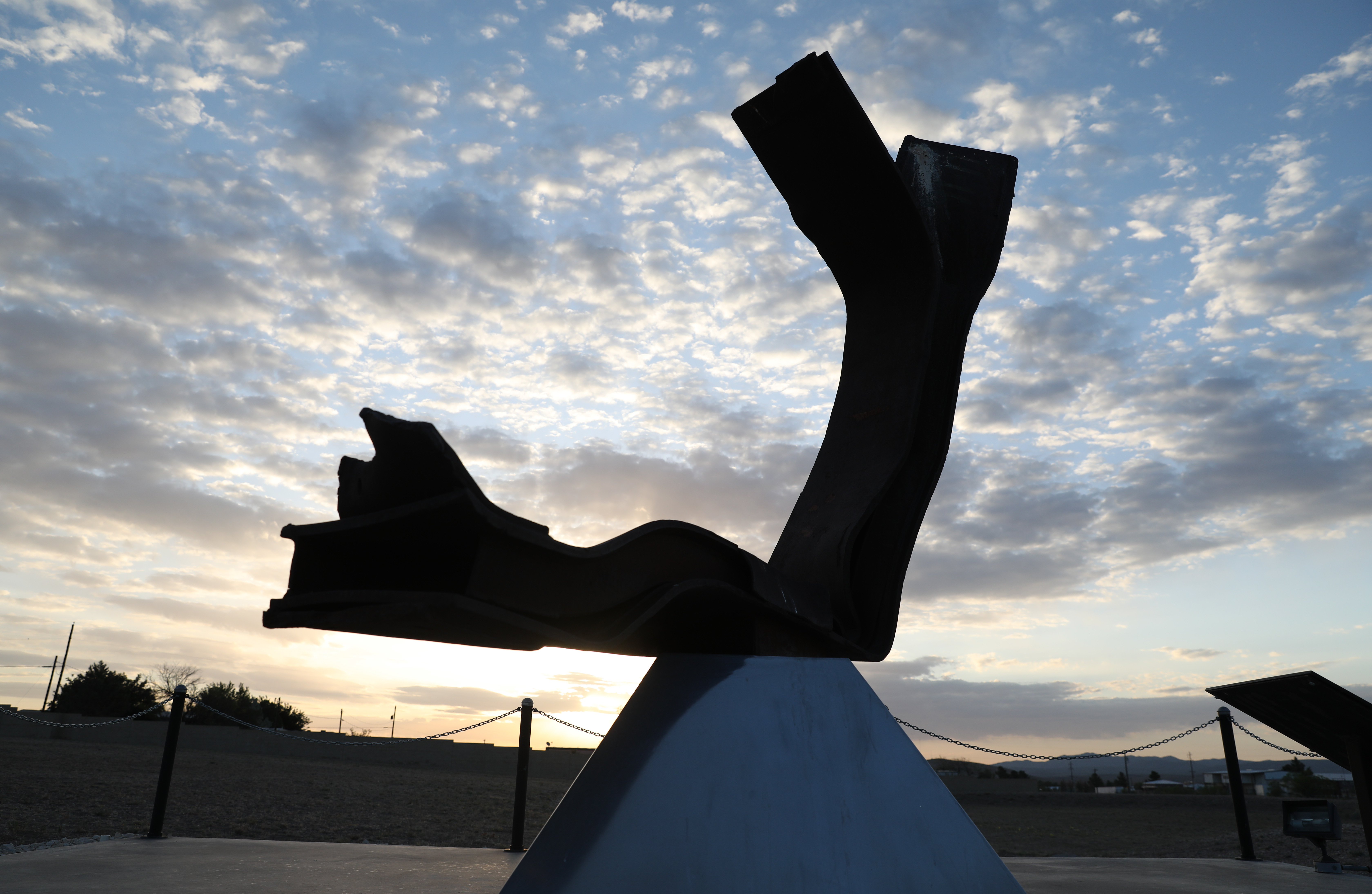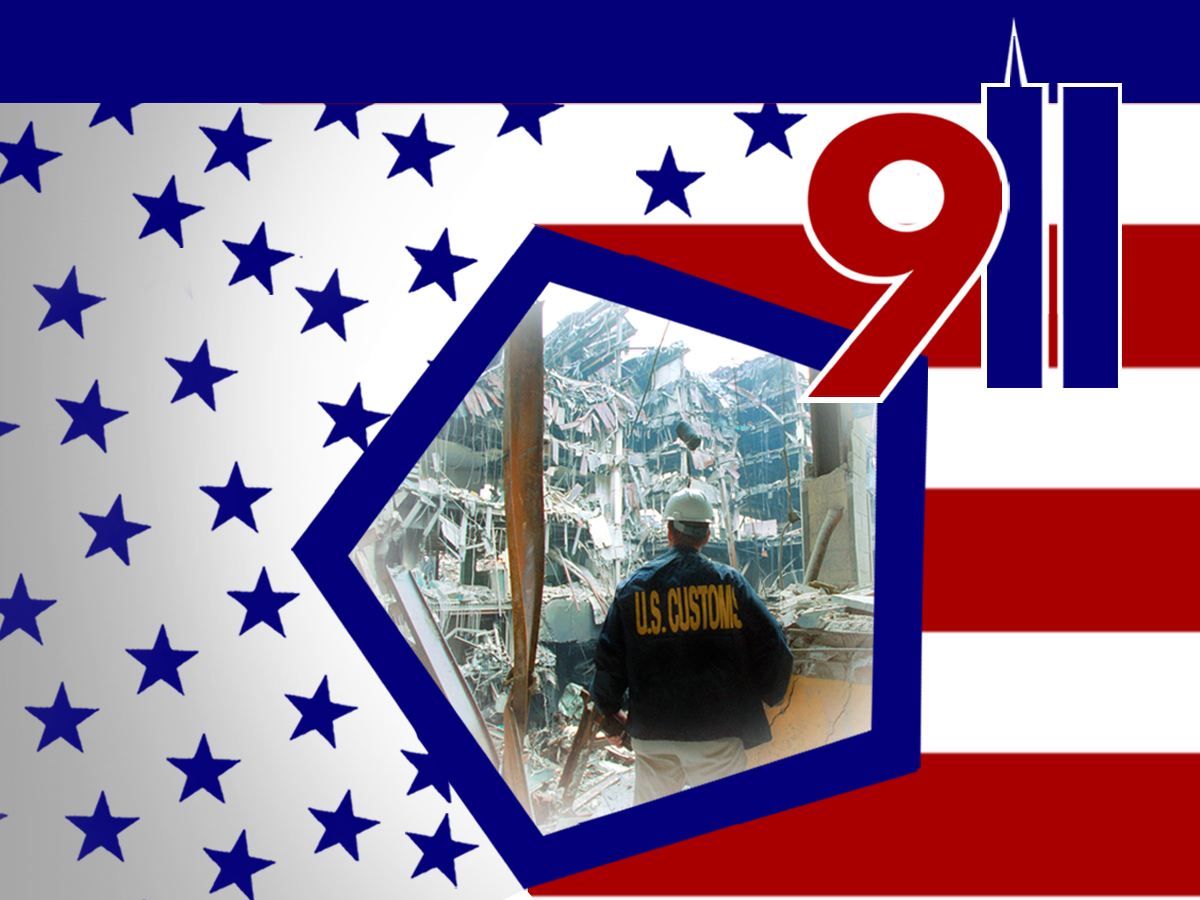
A Moment of Tragedy, a Catalyst for Change
U.S. Customs Special Agent Andy Danchuk surveys the damage inside the Customhouse in New York City following the Sept. 11, 2001, terrorist attacks. Photo by James Tourtellotte. Graphic illustration by Janice Swan Jones.
Twenty years ago, as former Air and Marine Operations Center executive director Tony Crowder stared at the TV screen showing the burning high-rise tower in New York City, he could only think of what a terrible accident it must have been.
“I thought, ‘That’s one lousy pilot. How the heck did he not miss,’” such a huge object as a towering office building on that clear, blue September day? Moments later at the U.S. Customs Service situation room at its headquarters in Washington, D.C. – which would become headquarters for today’s U.S. Customs and Border Protection – as he watched a second plane strike the tower’s twin, he knew this was no accident. “In law enforcement, this is what we would call a clue,” that this was actually an attack.
Halfway across the country, as then-Border Patrol Agent Gloria Chavez was flying in the early morning hours from south Texas, back to her home station in San Diego after a brief vacation, the pilot came on the intercom and let the passengers know they were being diverted to land in El Paso, Texas, where Chavez now serves as that sector’s chief patrol agent.
“You’re sitting in your chair in the airplane, thinking, ‘Why are we being diverted? The pilot did not say it was a mechanical problem. This has never happened to me before,’” Chavez said, still not realizing why the plane was being landed early. As she joined the other passengers from dozens of other flights filling the departure concourse, they were all drawn to the televisions broadcasting the news that a plane had hit one of the twin towers in New York. Moments later, she watched in horror as a second plane hit the other tower. Twenty years after first witnessing the terrorist attacks, Chavez still shudders thinking about the moment.
“The entire gate area just went silent,” compared with the chaos of all the people talking just an instant before, she said. “Everyone gasped when they saw the second plane hit that tower. Immediately, I thought, ‘We’re under attack. This is no accident.’”
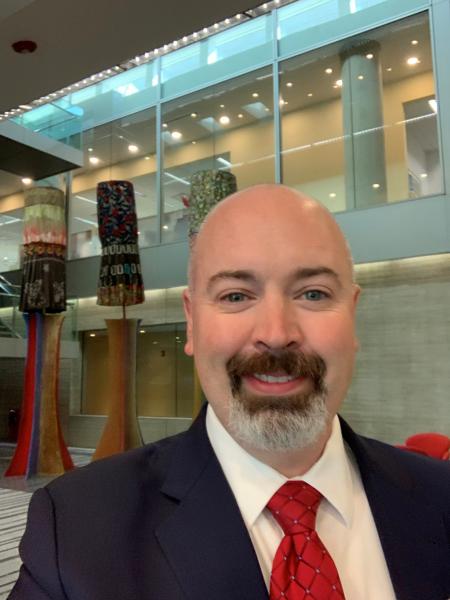
late 2019, McConachie visits
Beijing, where he now serves
as CBP’s attache to China.
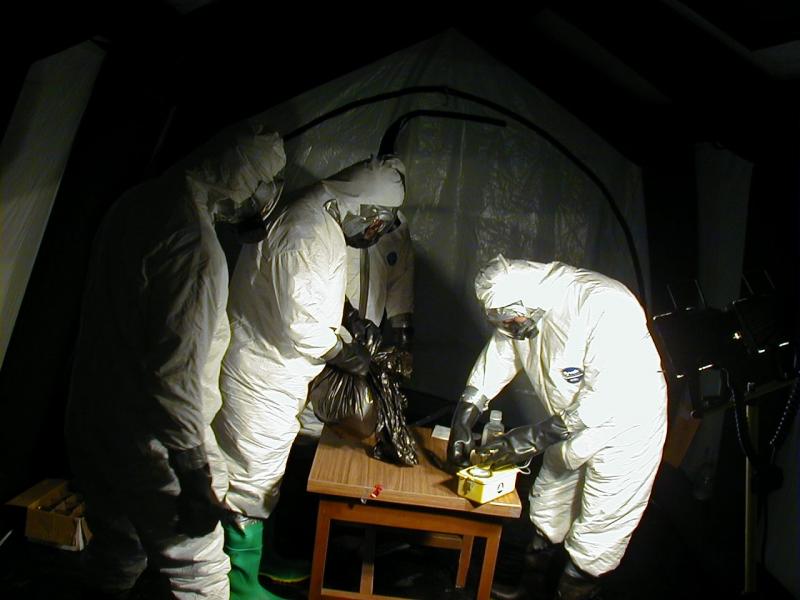
suit along with several other Customs
inspectors to protect them during the anthrax
scare that came just a short time after the
9/11 terrorist attacks in 2001.
A couple of hours later, a U.S. Customs Service inspector from Pittsburgh who also served as chief of the hazardous materials team and on the counter-terrorism task force for southwestern
Pennsylvania, Stephen “Mac” McConachie, would be in a field near Shanksville, Pennsylvania, sorting through the wreckage of United Airlines Flight 93 – the ill-fated plane thought to be headed for the U.S. Capitol but went down instead in this rural area after passengers fought back against their hijackers. But there was little to pick through.
“We were looking at a big hole in the ground where that plane crashed, and there was nothing we could do about it, nothing we could do to save anyone. There was no one to save,” said McConachie, who now works as the CBP attaché in Beijing. You can still hear the frustration and exasperation in his voice, 20 years later. “We couldn’t do a damn thing. There are few things more difficult for a first responder than to realize there is nothing you could do to help save people.”
He knew it was the start of a whole new world for America and for what would become CBP.
“We have become one of the world’s premier law enforcement agencies,” he said.
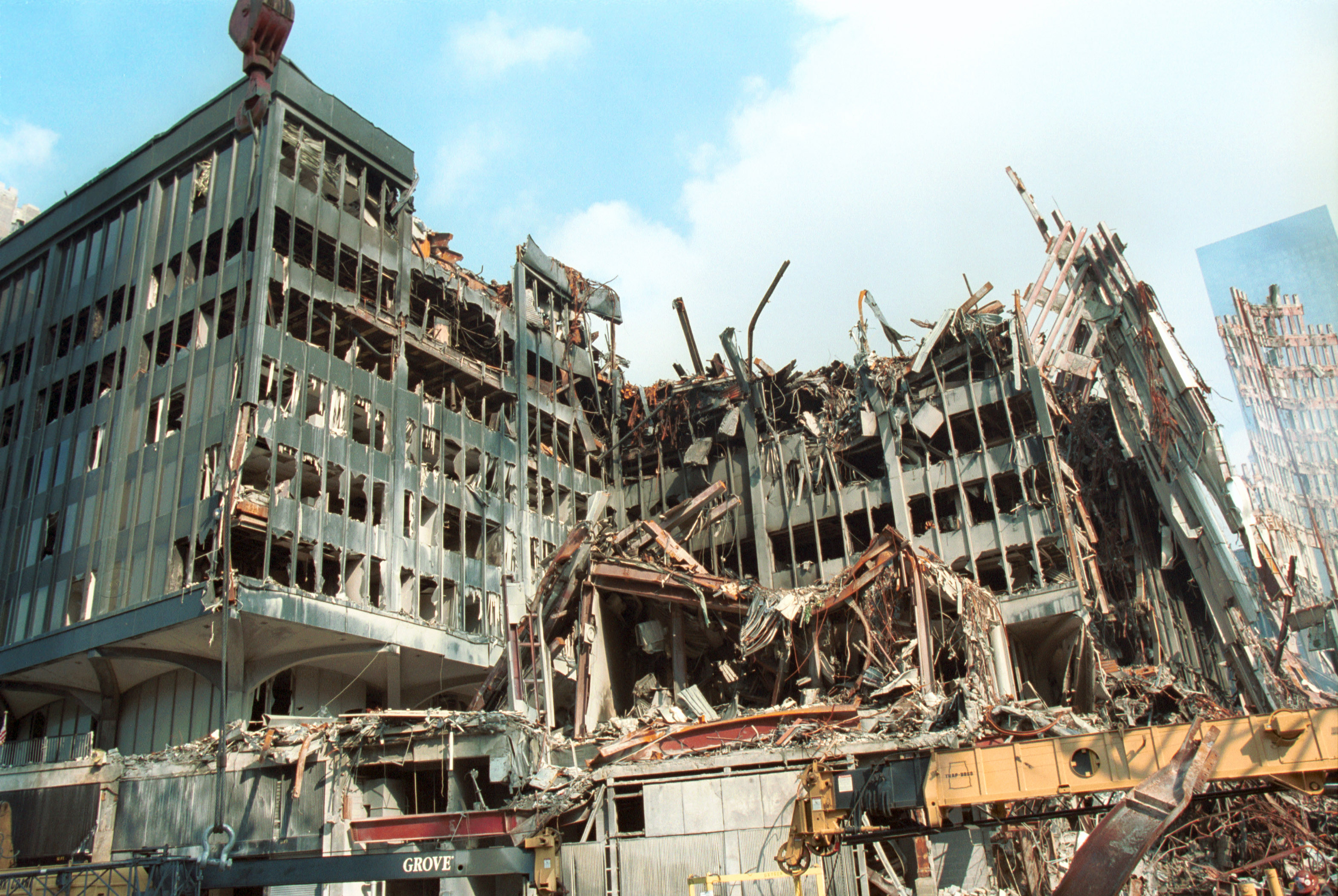
While the terrorist attacks of Sept. 11, 2001, are certainly a tragedy and dark day for the U.S., they’re also seen as a catalyst for change that made this nation’s security stronger in the long run. A big part of that change was the unification in March of 2003 of many separate entities at the time into one agency: U.S. Customs and Border Protection. CBP combined the employees and assets of several legacy agencies, including the U.S. Border Patrol, U.S. Customs Service, Immigration and Naturalization Service, the animal and plant inspection portions of the U.S. Department of Agriculture, as well as trade inspectors. This is a story of how the horrendous events of Sept. 11, 2001, not only unified these assets into one agency, but also how the attacks – and the events of the past 20 years – helped shape today’s CBP so that the agency is better integrated and aligned, with improved situational awareness across many domains.
A Prescient Assignment
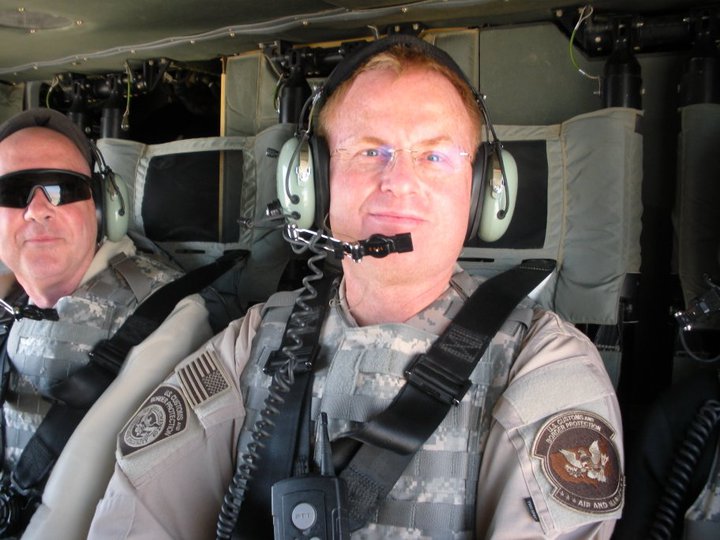
of the Air and Marine Operations Center, in
a Black Hawk helicopter over Iraq as he
compared his center’s processes with the
U.S. military’s special operations processes
in Iraq. Photo courtesy of Tony Crowder
It was fortuitous that Tony Crowder, who retired from government work in 2018 after 18 years working as the Air and Marine Operations Center executive director, happened to be working for Customs that day. He came to the agency in 2000 after serving in the U.S. Air Force for 20 years, including as an air battle manager. His background in directing fighters, bombers, and radar units was perfect for the task given to the agencies that would eventually become CBP: protecting the skies over the winter Olympics in 2002 in Salt Lake City. While in that role, Crowder and his team had brainstormed with his counterparts in the Federal Aviation Administration about the possible threats to the games. One scenario they envisioned was a terrorist attack involving the use of a non-commercial plane as a weapon.
“We started this work in 2000, and we’re devising what we think will be a package of techniques and procedures to mitigate this threat,” he said, realizing to cover all the aircraft, they had to work with the military. “We built procedures to blend our capabilities with [the military’s] capabilities and to apply this to a unified, cohesive, whole-of-government fashion against an air threat,” which included a better integrated radar system through the already established Air and Marine Operations Center in Riverside, California – an entity already working the air aspect of border security since 1988.
In the series of images , you can see the number of aircraft in the air over the U.S. – represented by the lighted dots – decrease in the hours after the terrorist attacks on Sept. 11, 2001. Graphics courtesy of CBP Air and Marine Operations.
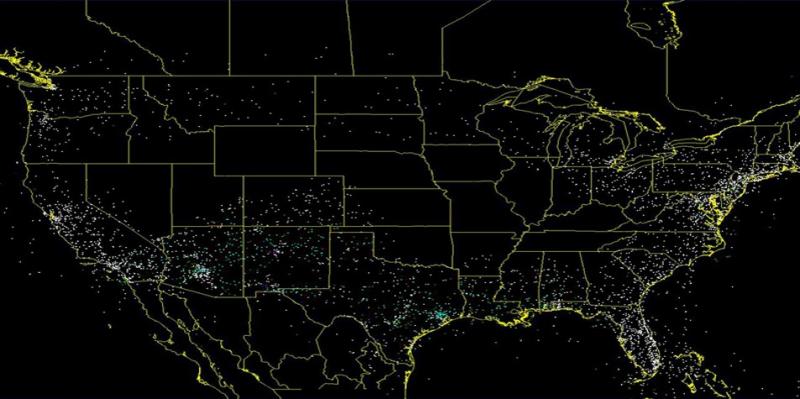
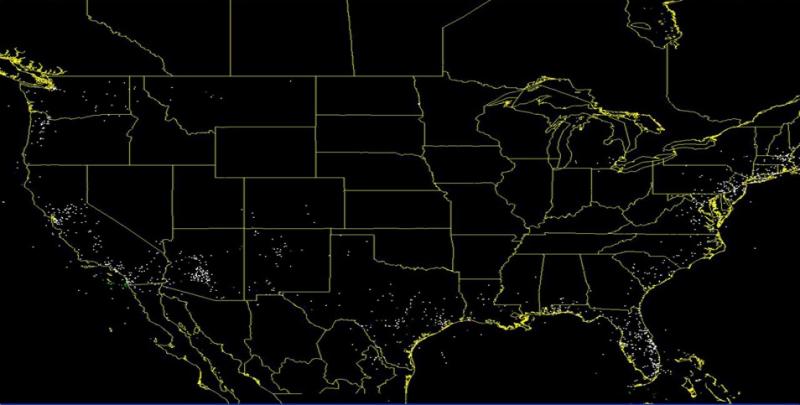
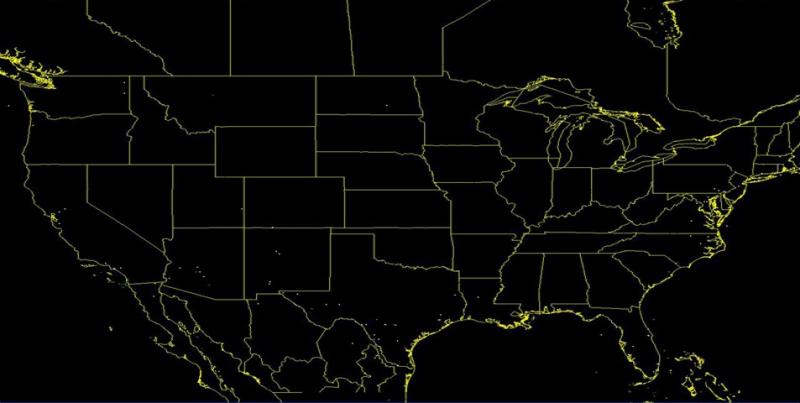
With the groundwork for this whole-of-government approach already set because of the upcoming winter Olympics, the air assets of Customs were quickly put into action on the morning of Sept. 11, 2001. Their preparation enabled them to work with the FAA get all aircraft on the ground on 9/11 and establishing an air bubble around the Washington, D.C., area.
“Since the [Air and Marine Operations Center] had this unique capability to see what’s happening in the air space, and communicate and reach out to law enforcement, we were able to work together with the FAA and the North American Aerospace Defense Command” – better known as NORAD – “to start clearing the skies of everything flying over the United States,” he said.
Then, with the eerie, surreal image of planes disappearing off the combined radar image as they landed early at airports across the country, Crowder and his crew had to get protective air assets to the Washington area – also known as the National Capital Region.
“We took this plan we developed to put an air security bubble over Salt Lake City, and we activated it for the National Capital Region,” Crowder said.
Part of that included moving Customs’ helicopters and planes cross-country and starting patrols – a heavy lift when you consider the agencies’ combined assets were such a small fraction of what other entities, such as the military, which brought airborne early warning aircraft to coordinate the air effort, could bring. However, even the military ended up handing over 25-30% of the critical infrastructure to Custom’s P-3 early warning aircraft, because the nation simply was not prepared for this type of event.
“The spirit of cooperation was remarkable. No bureaucracy, just operators [from our agencies and the military] getting on the line and figuring out what needed to happen,” he said. “We were punching above our weight class, because we took on huge national capabilities for which we had not anticipated.”
That cooperation and “punching above its weight class” seems to be a hallmark of CBP over the past 20 years. Stephen Boyer, who now leads CBP’s Office of Air and Marine Operations, was a Customs agent who had just gotten off a midnight shift working on a small boat off the coast of San Diego on 9/11. His deputy, Dennis Michelini, was a pilot working for Border Patrol in Laredo, Texas. They both knew the world had changed.
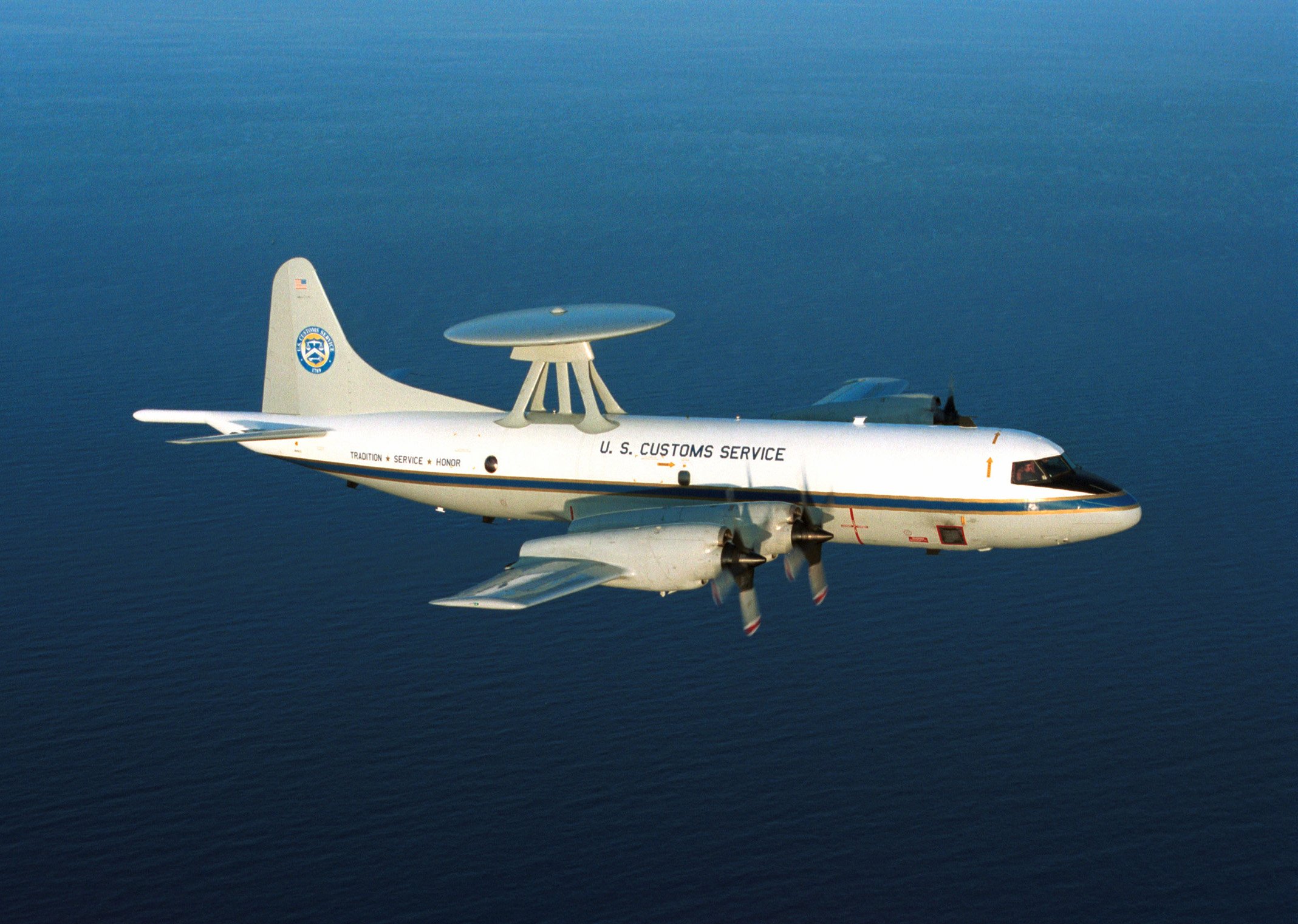
“People had to understand there was a real aviation and maritime threat to this country,” Boyer said. “There were real vulnerabilities in this country, and it is our job to try to help identify those and work those in the best way possible.”
Michelini admitted he didn’t know a lot about what happened in the immediate moments after the first plane struck the twin towers. But, as a pilot, he did know it was no accident, and they needed to get to work to fix the problems that allowed this terrorist act to happen.
“The stovepipes between state, local and federal [agencies] allowed the terrorists to move left and right within our country,” he said. “There was no communication.”
A few years later in 2006 when Air and Marine Operations became its own component under the larger CBP umbrella, it was seen as a method to break down those stovepipes and solve issues on a national level.
“For example, if a drug case starts at the border and an [Air and Marine Operations] helicopter is involved, then the helicopter can transition to, [Homeland Security Investigations – a part of Immigration and Customs Enforcement, another agency in the Department of Homeland Security] in Tucson or Phoenix,” Michelini said. “You let it become fluid with the needs of the moment,” whether those are border related, an investigation or stopping a terrorist.
That tearing down of stovepipes and making sure everyone knows what everyone else knows is key to how CBP has become more cooperative within its own agency and with other state, tribal, local and federal law enforcement partners.
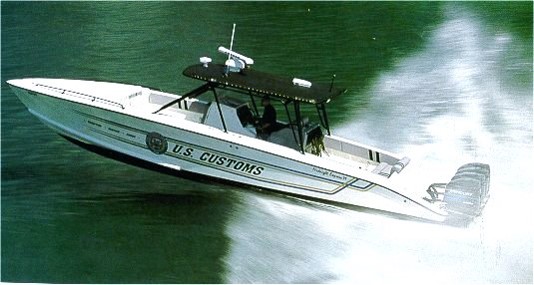
“CBP really tries to focus not just on the work at the borders but beyond the borders,” such as the efforts to fly P-3s – former U.S. Navy submarine hunters – along the coasts of Central and South America to intercept drug smugglers thousands of miles from U.S. shores, Boyer said. He added better integrated systems allow Air and Marine Operations to more easily communicate and cooperate with its Trade, Field Operations and Border Patrol brethren within this one, unified agency. “I think that’s really critical.”
Chavez said she’s seen a marked difference in how the Border Patrol operates today compared to 2001.
“Even though we shared information with other agencies or worked together in great partnerships [before 9/11], we were truly siloed agencies. We were not as integrated and aligned as we are now with improved situational awareness across many domains because of information sharing and technological advancements,” she added. Because of this colossal tragic event in U.S. history with so many lives lost, there was a sense of obligation and responsibility among agencies to improve their seamless coordination and processes to prevent a terrorist attack from ever happening again in the U.S. “As a result of 9/11, the Department of Homeland Security was formed, which gave birth to U.S. Customs and Border Protection, an agency that now would house the Border Patrol, Office of Field Operations – Customs, agriculture specialists, immigration officers – and Air and Marine Operations. So now you have three enforcement agencies along with [the Office of] Trade … all four [components] combined into one overarching national security agency in CBP, giving us that integration and focused mission on what we’re here to do. Thinking back, the U.S. Border Patrol’s greatest benefit was transferring as one complete law enforcement entity into our new home at CBP.”
A New Day, A New Sense of Cooperation
That spirit of cooperation born out of the necessity of a response to the terrorist attacks became a common thread for CBP, as the agency combined the assets and skills of a diverse group of agencies, which had a similar goal of border security but used to take divergent paths to get there.
“At ports of entry, we had [Immigration and Naturalization Services] and [Department of Agriculture, in addition to Customs inspectors]. Depending on personalities involved, it affected how the relationship went,” said William Ferrara, who on Sept. 11, 2001, was a Customs inspector, working in the situation room at headquarters in Washington. Now, after more than 30 years of government service, he is the executive assistant commissioner for CBP’s Office of Field Operations, the same blue-uniformed officers who made up the old U.S. Customs Service. He said before 2001, in some locations, the agencies worked well together while other places weren’t as cohesive.
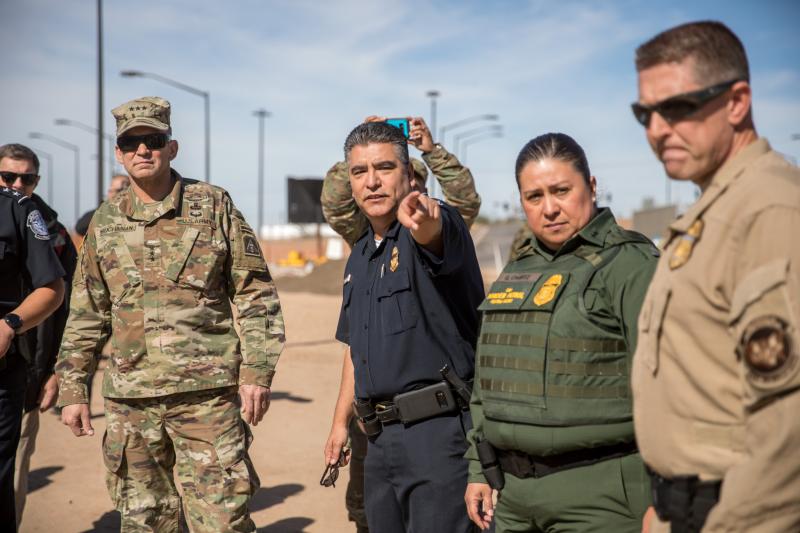
David Salazar guides U.S. Army North Commander Lt. Gen.
Jeffrey Buchanan on a tour of the Calexico West Port of
Entry. They are accompanied by Chief Patrol Agent Gloria
Chavez from the Border Patrol’s El Paso, Texas, sector,
and San Diego Director of Field Operations Pete Flores.
Photo by Ralph Desio
“Tearing down barriers and creating one CBP was absolutely the right thing to do, because now, we have a unified border security approach at a port of entry; there’s only one entity that’s responsible for all those same functions,” he said. “We’ve raised security and efficiency in how we process people and legitimate trade. That wouldn’t have been possible if we had to check off all three boxes to get something done.”
The chasm between priorities even within the old U.S. Customs is illustrated as Ferrara relates his own experience as a young inspector more than 30 years ago in Calexico, California. At the time, the port of entry had eight vehicle lanes checking for drugs, illegal materials and other violations of immigration law. However, each inspector had different mission priorities: Customs inspectors checked for drugs, weapons, and currency, whereas Immigration and Naturalization Services inspectors checked for immigration violations.
“Now, if that same car drives up, our CBP officers are looking for all threats, equally,” he said.
Chavez said a great benefit she has seen in her time under a unified CBP is the ability to adapt to new threats.
“We have evolved to be agile, adaptable, rapid response driven to any type of threat or situation that could arise,” she said. “It amazes me how we [as Border Patrol] formed in 1924, started protecting the borders of our nation by doing mounted patrols on horseback, and have now evolved with Border Patrol agents deployed all over the world, as attaches and advisors in roles that are simultaneously influencing and strengthening the U.S. and other countries globally, fortifying our partnerships to fight terrorism beyond our own borders.”
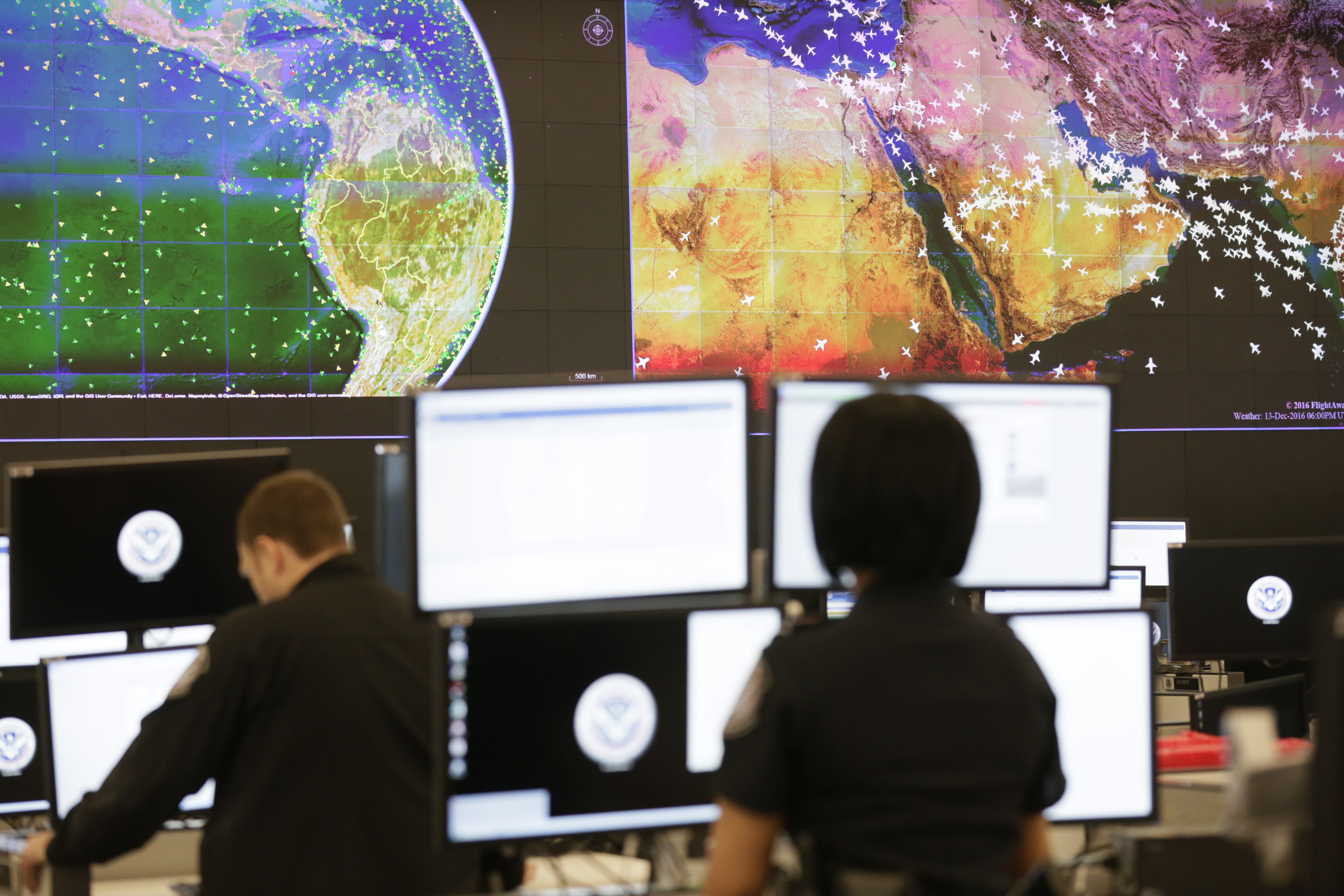
Finding Targets of Opportunity
Bringing together all the capabilities that the modern CBP possesses has made the former agencies – now united – much greater than the sum of their former parts.
“CBP is in a unique position on the frontline,” said Ferrara. “We have the ability to work with our other partners in the U.S. government to obtain and analyze information that allows us to make tactical and strategic decisions.”
One decision that shows the cooperation and ability to connect the dots now was the establishment of the National Targeting Center, stood up just a month following the Sept. 11, 2001, attacks. In an ordinary looking building in Sterling, Virginia, just about 20 miles from the center of U.S. government in Washington, D.C., CBP has assembled a team of experts who analyze a variety of information. They look at a range of data from passengers who have passed through U.S. ports of entry, cargo business information and intelligence, information gleaned from Border Patrol apprehensions along the northern and southern U.S. borders, and inbound and outbound flights monitored by the Air and Marine Operations Center in California. In addition, partnerships with federal, state, local and tribal law enforcement agencies provide the targeting center with data to connect those dots and make sure the puzzle pieces are put together to give the agency the complete picture of who and what are coming into the country, as well as letting the intelligence analysts better predict when and where those who want to inflict harm upon on the U.S. might try to strike long before any attack happens. In other words, the center identifies threats before they happen, keeping the experts one step ahead of the bad guys.
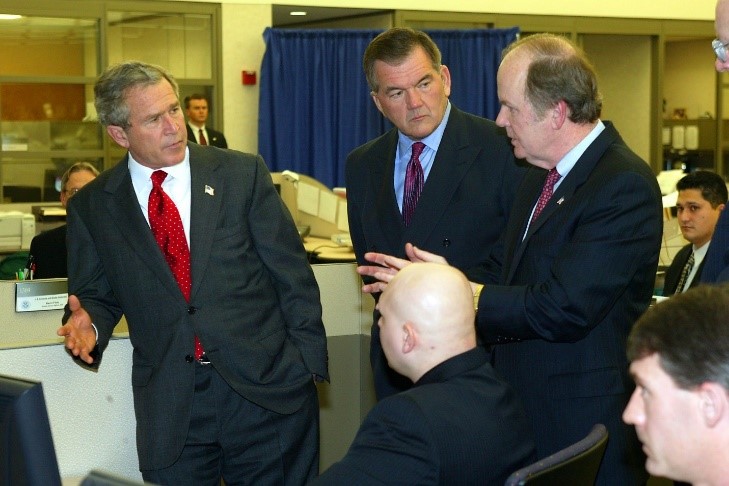
and then-Secretary of Homeland Security Tom Ridge listen
to then CBP Commissioner Robert Bonner as he describes
the mission of the National Targeting Center. Photo by
James Tourtellotte
Economic Security = National Security
Another key function for CBP today is keeping trade flowing.
In the days and weeks that followed the attacks, the stock market reflected the uncertainty and fear that embodied America’s collective experience. Oil and gas prices surged as supply chain security was called into question. Travel and airline industries took a major hit. The attacks made it very clear that economic security and national security were two sides of the same coin.
“National and economic security took on a new meaning after 9/11,” said AnnMarie Highsmith, the executive assistant commissioner for CBP’s Office of Trade. “With the formation of DHS, America’s prosperity and economic security were at the forefront of the homeland security mission,” she said.
She remembers that day vividly. At the time, she was working as a staff attorney in Customs’ Long Beach, California office.
“I was up early that morning with my infant daughter and turned on the news to see that the first plane had just hit the World Trade Center,” Highsmith said.
Unable to process what she saw, she picked up the phone to call CBP’s chief counsel. Together, they watched the second plane crash into the second tower in utter disbelief. They held their breath as they awaited the news of hundreds of their Customs colleagues who were working in the World Trade Center. Fortunately, they all made it out safely.
Highsmith experienced the impacts in other ways as well, all the way on the other side of the country in California. She lived right next to the Los Angeles International Airport, where the continuous movement of incoming and outgoing air traffic generated a regular cadence. In the wake of the attacks, the sounds of flight that she was so accustomed to ceased as airports across the country grounded their planes.
“The silence was deafening,” she recalled. “It was the sound of the largest economy in the history of the world grinding to a halt.”
Both the airport and the Long Beach seaport were eerily quiet as Highsmith – and the rest of the world – spent the next few days grappling with what had happened.
“I felt a call that there was more to be done,” she said, reflecting on the pivotal moment that changed her career trajectory for good.
Like many in the CBP community, the attacks and their aftermath inspired Highsmith to be a part of the solution that would keep something like this from happening again.
Within a few weeks after the attacks, the economy started to level out and America began the painful journey toward recovery. This meant rebuilding the nation’s national security strategy to address a new type of threat.
“The Fifth Act of Congress in 1789 established the U.S. Customs Service to help rebuild” the economies of the 13 colonies that became the United States after the Revolutionary War, Highsmith explained. “The establishment of CBP and all of the offices that contribute to the trade mission helped us rebuild after 9/11.”
Revenue collection was significantly streamlined by the establishment of the Automated Commercial Environment. Also known as the “Single Window,” it is the portal through which trade-related data required by all U.S. government agencies is submitted and processed. It is the backbone of trade facilitation and enforcement, and it stands as a role model for other countries. The Automated Commercial Environment is used to collect customs duties, taxes, and fees, and in fiscal year 2020, its automation simplification efforts resulted in $1.75 billion in processing efficiencies and increased economic benefits – both for CBP and the American trade community.
“American prosperity is built on economic security, which is underpinned by legitimate trade and effective enforcement made possible by [the Automated Commercial Environment] and CBP’s dedicated staff,” said Jim Byram, executive director in the Office of Trade.
Lawful, legitimate trade is the foundation of the American economy, but there are many who seek to exploit the largest economy in the world for their own financial gains. Illegal trade practices expose the American public to a host of potential hazards and danger. CBP identifies vulnerabilities to the nation’s economic security by disrupting terrorist financing, targeting fraud and counterfeits, and ensuring supply chain transparency. The Office of Trade identifies threats, such as trade-based money laundering, which can involve moving illicit goods to fund criminal activity.
CBP’s trade personnel also work to develop global regulations and standards to protect national security from foreign investments in supply chains.
“Since 9/11, we have significantly expanded our ability to track and disrupt terrorist and criminal financing through combating bulk cash smuggling, fraud, human trafficking organizations, and retail crime rings,” Highsmith said.
One way CBP is combating crime is through the Commercial Targeting and Analysis Center in CBP’s Office of Trade, which facilitates information-sharing and leverages the collective resources of partner government agencies to prevent, deter, interdict and investigate violations of U.S. import and export laws, and reduce illicit trade in unsafe products.
Pinky Khan is a branch chief for the center, and she shared that the disruption of the importation of something seemingly innocuous, such as an endangered species of fish, can make a huge difference when revenues reaped by the illegal fishers often fund more nefarious activities.
“You’ve got cartels that are involved, you’ve got human trafficking, forced labor issues [including children],” she said. “By us seizing one shipment, we are able to make an impact on the overall illicit operation.”
These actions send a strong message to the illegal international trade community that CBP is using precise targeting skills, and we will catch and prosecute these bad actors for their illegal imports.
The Office of Trade continues to modernize its efforts in trade enforcement, facilitation, and revenue protection through the 21st Century Customs Framework. This initiative takes a broader, whole-of-government approach, consistent with CBP’s overall efforts to better communicate within and outside of the agency.
“We’re picking apart and looking at our legal and regulatory framework and identifying changes to address today’s and tomorrow’s trade challenges, while also propelling the U.S. forward in leading global trade transformation,” said Garrett Wright, the director of trade modernization for the Office of Trade.
One of the challenges is updating legal authorities that are nearly three decades old and must reflect the modern world of ordering something through the click of a computer mouse from halfway around the world and having it show up on a customer’s doorstep just a few days later.
The exponential growth of e-commerce has benefited the U.S. economy, but the increase in small packages has also enabled illicit online trafficking in goods that range from illegal to dangerous, such as counterfeit drugs.
“Those fake Gucci handbags? The people profiting off those are not our friends. There is a direct line from intellectual property rights violations to criminal enterprises,” Highsmith said.
It’s not just bags and pharmaceuticals. Since the beginning of the COVID-19 pandemic, CBP has seen an uptick in counterfeit, unapproved, or otherwise substandard COVID-19 related products that threatened the health and safety of Americans. By the end of June 2021, the agency had seized nearly 40 million counterfeit face masks.
“Our enforcement work on counterfeit trade is more critical than ever, as we monitor activity by strategic competitors like China that have extensive global trade and investment networks,” Highsmith said. “Directed foreign investment in supply chains can undermine national security, and we’re on the frontline to develop global regulations and standards to protect things like intellectual property.”
One of the current shortcomings the 21st Century Customs Framework looks to tackle is the lack of visibility in some global supply chains.
“We, and our industry partners for that matter, don’t see a large swath of global supply chains, and that lack of visibility puts American consumers, domestic businesses, and our economic and national security at risk,” Wright said, adding that the framework will help paint a more complete picture of the nature and origin of imports. “With the right information, from the right parties, and at the right time, CBP can better protect the economy and other U.S. interests and equities from counterfeits, unsafe products, duty evasion schemes, and other illicit trade.”
He explained how the framework CBP is developing would also create more predictability and efficiencies for industry.
“This would support faster clearances [of imported items], because the more we know about what’s coming into the country, the more information we have about what’s in the box, where it’s coming from and where it’s going, the better able we are to identify and segment out low-risk from high-risk items,” Wright said.
He made no bones about the importance he sees Trade playing in the overall security situation that has evolved in the last 20 years.
“We are the tip of the spear when it comes to preventing illicit trade from entering our stream of commerce,” Wright said. “Addressing threats at the earliest possible point is essential to strengthen the security of our country.”
Looking Back, Moving Forward
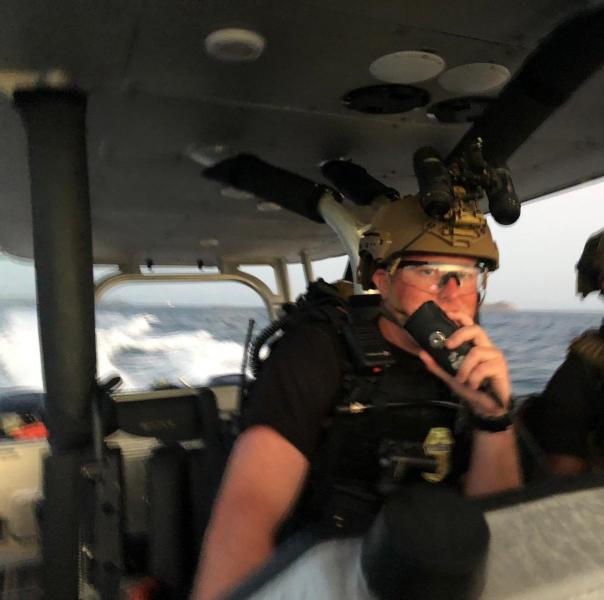
of a patrol near the U.S. Virgin Islands. Wert
was just a child on Sept. 11, 2001, but he
says the event affected the track of his life.
Photo courtesy Marine Interdiction Agent
Raymond Wert
As one of the newest hires for CBP graduating from the Air and Marine Operations Academy in April, Marine Interdiction Agent Raymond Wert, now stationed in the U.S. Virgin Islands, doesn’t really have a time before 9/11 to compare his experience with CBP. In fact, on that fateful day in 2001, he was just a child who had a few days before flown from Texas to visit his grandparents in Michigan to celebrate his birthday. Instead of flying back home on Sept. 12, 2001, he went on a road trip with his grandparents to meet his parents halfway between the northern and southern states because all commercial flights were canceled for about a week. He knew this was a turning point for him and for the nation even at a young age.
“I realized what it meant to be an American, seeing the whole country coming together,” Wert said.
His own path would lead him to join the U.S. Coast Guard after high school, where he would serve in the Persian Gulf. His 10-year stint in the Coast Guard and his new assignment now in the Caribbean far from the shores of the mainland U.S. opened his eyes even further to what could still be lurking out there.
“The threat is constant,” he said. “With the ever-present threat, if no one is here to protect the nation, we’re going to lose [our American way of life].”
Ferrara hopes Americans never forget the lessons learned from 9/11 when it comes to security, which starts at the U.S. border and beyond.
“That threat is continual, ever-changing, and still present,” he said. “National security will always remain our greatest priority. The efficiencies we’ve developed over the past 20 years have put us in a better position to stop future attacks.”
Chavez echoed Ferrara’s sentiments of staying one step ahead of the bad guys.
“In the future, we cannot miss a step. We don’t have time to rest. The threat is 24/7,” she said. “Just as they planned attacks against the U.S. in 2001, there are organizations out there today planning the same in this decade, in this century. So, we have to be restless in our quest to always stay one step ahead of terrorism. CBP is a very important player among agencies on the national security front.”
Boyer said the terrorist attacks of 20 years ago made the public better understand there are threats out there. And it made the people in the legacy agencies that became CBP better understand how they would be key in preventing another event such as what happened in Washington, New York and Pennsylvania for the two decades since.
“We’ve become much more proactive versus reactive,” Boyer said. “The significant event to me is the non-event that’s taking place: We have not had another major attack on U.S. soil. That says a lot to me.”
McConachie – in his mind – still walks through that Pennsylvania farm field 20 years later. But while he still laments not being able to do anything to save the passengers of Flight 93, he hopes what he and CBP have done since then has made a difference.
“We’re much more focused on threats today than we were then,” he said. “We are now an all-threats, all-hazards agency. We have to be.”
Crowder said having people at an Air and Marine Operations Center who had considered the possibility of a plane being used as a weapon and a guy like him who understood the intricacies of an air battle plan, along with a relationship with other security agencies who were planning for a winter Olympics about six months down the road, must have been some kind of divine, cosmic aligning of everyone and everything that needed to be in place on that terrible September day 20 years ago. He hopes it’s also been an aligning of the stars to prevent the next 9/11.
“You can’t predict when the next crisis will come. The threat set does not begin and end at the border,” Crowder said, adding the threat is a continuum, whether it’s traffickers, terrorists, or smugglers. “You can’t attack these multi-faceted security threats with just one screwdriver in the tool kit. It’s a multi-mission capability. 9/11 was just an example of how you can take core competencies and apply them to all kinds of national security problems.”
Below, the Sept. 11, 2001, memorial at Alpine Border Patrol Station in Texas. Alpine Station has a direct connection to the terrorist attacks on 9/11, as there was a ground-breaking ceremony that fateful day for the station building. Ten years after the event, a memorial using a large piece of steel from the World Trade Center Towers was erected and now stands as a reminder of the importance of CBP’s mission of keeping America safe from future attacks. Photo by Greg L. Davis
